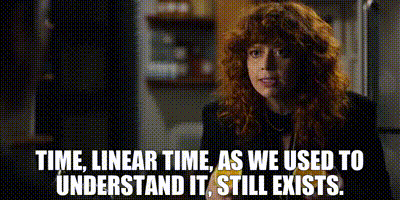Finding Clarity When Time Itself Is Collapsing
Note: This article is part of my examination of Horizon within the SHIFT model. In our SHIFT courses, we explore each SHIFT element at both the macro (systems) level and micro (individual leader) level. Today we look at the micro, how you can trust yourself even when the pace of change seems to be outpacing you. On Friday, we’ll explore the macro with The Skill Revolution: 3 Trends From Companies Getting Development Right.
Last week, a former client messaged me: "Your Pre-Election video series on self-regulation was exactly what I needed today." I was confused—it was January 25th. Published in November, yet there they were, appearing in her January feed as if brand new.
This is time collapse—where past, present, and future blur together, creating a sense that everything is happening at once. And it's not just happening on social media.
When Everything Happens at Once
You've probably felt it in your work.
The strategy you finalized last quarter already feels outdated.
The market shift you anticipated for next year is happening now.
The technology rollout planned for 18 months needs to be completed in six.
This compression creates real conflicts:
How do you plan when timelines keep shrinking?
How do you make decisions when solutions become obsolete so quickly?
How do you maintain your organization’s culture and identity amid constant reinvention?
News cycles, digital communication, and market pressures amplify this collapse. Headlines distort your sense of when things happened. Changes that once took years now unfold overnight.
There are no easy solutions to time collapse. But some leaders are navigating it differently. Instead of getting pulled into reactive cycles, they look for patterns and possibilities others miss.
It’s not that they’re faster or more prescient—it’s their perspective. They’ve developed a macro view that combines external awareness with internal clarity.ness.
Trusting What You Already Know
When time collapses like this, traditional decision-making approaches often fail. The key is balancing external data with internal insights.
Cut Through Information Overload
When everything feels urgent, consuming more information rarely helps.
I’m a data geek—I love diving into research and exploring new theories. But over time, I’ve come to appreciate that my deepest insights don’t come from more data—they come from trusting the expertise I’ve built.
Instead of chasing more information, ask:
"What do I already know about where my industry is heading?"
Shifting from gathering to clarifying can unlock better decisions.
Listen to Your Experienced Mind
After years in your field, you’ve developed pattern recognition that operates below conscious awareness.
When something doesn’t feel right—even if the analysis looks solid—pay attention. That feeling often signals an important insight you haven’t yet articulated.
This isn’t mystical—it’s your brain processing accumulated experience.
Connect with Future Possibilities
Beyond analyzing trends, actively imagine the future you’re trying to create.
Set aside time not just to plan but to mentally place yourself in that future. This practice helps you stay grounded when everything else feels chaotic.
Making Space for Clarity
You can’t develop perspective when you’re constantly reacting. Here’s how to create the space you need:
Build in Thoughtful Pauses
Block regular "slow time" to disconnect from notifications and reflect on the bigger picture. Even 30 minutes can help you maintain perspective when everything else feels rushed.
Ask Different Questions
When you need a broader view, try:
"What patterns connect the disruptions we’re experiencing?"
"What possibilities are opening that weren’t available before?"
These shift your thinking from reactive to expansive.
Combine Analysis with Intuition
Strategic clarity emerges when analytical thinking and intuitive understanding work together. Neither alone is sufficient—you need both.
Staying Grounded When Everything Shifts
In a time-collapsed world, your organization’s identity faces unique challenges. How do you evolve without losing yourself?
Return to Your Purpose
When making tough decisions, reconnect with why your work matters. This clarity provides a guiding anchor when traditional planning fails.
Create Directional Clarity
Rather than rigid plans that quickly become obsolete, define a flexible framework that clarifies:
The key problems you're committed to solving
The capabilities you’ll continue building
The values that will guide your decisions
This keeps you adaptable without losing coherence
Leveraging the Present in Acceleration
While time collapse creates challenges, it also creates opportunities. Strategic shifts that once took years can now unfold in months.
When you maintain perspective, these accelerated cycles enable faster learning and adaptation. What once required a decade might now be possible in a single push.
The leaders who thrive aren’t fighting time collapse—they’re finding advantage in it. By maintaining clarity amid acceleration, you can spot opportunities that others miss in the blur.
This week’s theme: Horizon Strength—The Future-Focused Leader.
In today’s fast-changing world, leadership isn’t just about reacting to challenges—it’s about anticipating what’s next and guiding others through uncertainty. Horizon leaders excel at this. But even the best future-thinkers can struggle to turn vision into action.
What about you? Where do you feel most in flow as a leader? Where do you want to have more impact but aren’t sure how?
If these questions resonate, take the 1 minute SHIFT Leadership Strength Quiz to discover how your strengths shape the way you lead—and how to maximize them.
\





